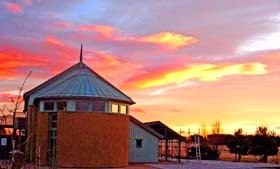Pieter and Raquel
|
Seriously, it was hard to move my focus from the daily round here out onto the open road. The A96 to be precise. However, once I was behind a wheel again the old habits clicked right back in and I became normal again.
Our carefully planned day took us first to Clava Cairns, three Bronze Age stone burial mounds lying just east of Inverness and dating from three to four thousand years ago. They are astounding, so astounding that they are actually a "type" site. That means that cairns like these are called "Clava" cairns even if they're not at Clava.
 | ||
| Each cairn was surrounded by a stone circle some time after it was first built, but still a very long time ago.
|
 |
| The lowest course lining the cavity at the center of each cairn is made up of large stones like these. |
Battlefield Thoughts
Our second port of call was
the battlefield at Culloden, very near Clava Cairns. I have to make a small
digression here to recall that some years ago I took my oldest grandson, Damon,
out for a day to visit Crown Point, a pre-US Revolutionary War fort in New York
State. As we crossed the stunning bridge across Lake Champlain at
Chimney Point, crossing from Vermont into New York, we saw a curious sight. A
handful of people dressed very strangely ran down from the foot to the lake on
the New York side, jumped into a rowboat and rowed quickly off.
When we arrived at the fort we
found a battle re-enactment going on. Soldiers were camped out all over the
place. They didn't look very American to me so I asked what battle they were
re-enacting and was told "Culloden". The people running down to the rowboat had been Bonnie Prince Charlie and his friends escaping from the battlefield.
So when I realized that Culloden battlefield lay on our route to Loch Ness, I decided to stop there. to connect with the sadness of the place. I should have known better. It's a huge open field, yes, I should be thankful for that, but it's also a tourist attraction with coffee bar and gift shop, which all felt a bit odd to me. Maybe it's better to preserve it this way than to forget it altogether - or is it?
So when I realized that Culloden battlefield lay on our route to Loch Ness, I decided to stop there. to connect with the sadness of the place. I should have known better. It's a huge open field, yes, I should be thankful for that, but it's also a tourist attraction with coffee bar and gift shop, which all felt a bit odd to me. Maybe it's better to preserve it this way than to forget it altogether - or is it?
 |
| Site of the Battle of Culloden, April 16, 1746 |
Onward to Loch Ness
Glaciation is an extraordinary
process which began to be elucidated in a scientific way for the benefit
of our current culture in the mid 1700s. Both Loch Ness in northern Scotland
and Lake Champlain in the northern USA/southern Canada are glacial lakes.
I live beside one of them and here I was visiting the other, so I ran a
comparison:
- Loch Ness is 23 miles (37km) long; Lake Champlain is 125 miles (201 km) long.
- Surface area of Loch Ness is 22 square miles (56 square km); surface area of Lake Champlain is 490 square miles ( 1,269 square km).
- Maximum depth of Loch Ness is 788 ft (240m); maximum depth of Lake Champlain is 400 ft (120m).
Its great
depth means that Loch Ness is the largest body of freshwater in the UK. Lake
Champlain is, I believe, the eleventh largest lake in the USA.
We took the road along the south-eastern side of the Loch, the B852. Several people had recommended it, omitting to point out that it's single lane, with passing places, as so many minor roads are this far from civilization. That was no problem, however, and it was an extremely good route for us because, unlike the main road on the other side of the Loch, it allows easy access at several points to the waters of the Loch itself. We stopped several times along the way.
We took the road along the south-eastern side of the Loch, the B852. Several people had recommended it, omitting to point out that it's single lane, with passing places, as so many minor roads are this far from civilization. That was no problem, however, and it was an extremely good route for us because, unlike the main road on the other side of the Loch, it allows easy access at several points to the waters of the Loch itself. We stopped several times along the way.
 |
| Loch Ness from the west about 1pm, Tuesday, March 10, 2015. |
 |
| Raquel demonstrating easy access to the Loch |
 |
| Welcome to Loch Ness |
Our destination was the small, and I mean small, settlement of Foyers, about half way along the Loch. We ate lunch, then ventured down to the 165ft (50m) Falls of Foyers .
 |
| Squirrels seem to be quite important to the people of Foyers. . |
 |
| Perhaps because they're so cute. |
We took a scenic route back, past Loch Mhor and Loch Ruthven, relishing the sensation of being beyond the firm embrace of the Findhorn Community for a day, but being sure to reach Cluny in time for dinner!
 |
| Goodbye, Loch Ness. 5pm, Tuesday March 10, 2015. |
More views of Loch Ness:


















